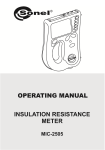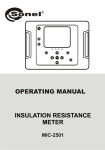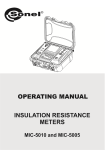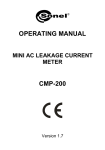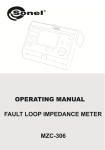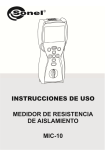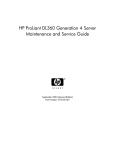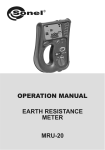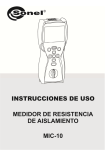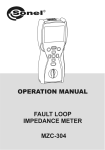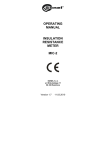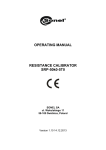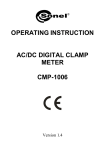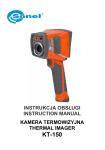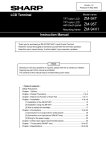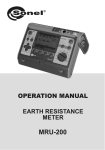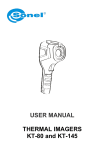Download "user manual"
Transcript
OPERATING MANUAL INSULATION RESISTANCE METER MIC-2510 SONEL SA ul. Wokulskiego 11 58-100 Świdnica Version 1.09 15.06.2015 MIC-2510 meter is a modern, easy and safe measuring device. Please acquaint yourself with the present manual in order to avoid measuring errors and prevent possible problems related to operation of the meter. CONTENTS 1 SAFETY ....................................................................................................................4 2 METER CONFIGURATION ..................................................................................5 3 MEASUREMENTS ..................................................................................................7 3.1 MEASUREMENT OF INSULATION RESISTANCE ...........................................................7 3.1.1 Double-lead measurement .............................................................................8 3.1.2 Three-lead measurement .............................................................................12 3.1.3 Measurement with AutoISO-2500 adapter ..................................................13 3.2 LOW-VOLTAGE MEASUREMENT OF RESISTANCE ......................................................17 3.2.1 Measurement of resistance of protective conductors and equipotential bonding with ±200 mA current ....................................................................17 3.2.2 Measurement of resistance ..........................................................................18 3.2.3 Calibration of test leads...............................................................................19 3.3 VOLTAGE MEASUREMENT .....................................................................................20 3.4 TEMPERATURE MEASUREMENT .............................................................................21 4 MEMORY OF MEASUREMENT RESULTS ....................................................21 4.1 STORING THE MEASUREMENT RESULTS IN THE MEMORY .........................................22 4.2 VIEWING MEMORY DATA .......................................................................................24 4.3 DELETING MEMORY DATA .....................................................................................25 4.3.1 Deleting bank data.......................................................................................25 4.3.2 Deleting the whole memory .........................................................................26 5 DATA TRANSMISSION .......................................................................................28 5.1 5.2 5.3 COMPUTER CONNECTION ACCESSORIES ................................................................28 DATA TRANSMISSION WITH USB PORT ...................................................................28 DATA TRANSMISSION WITH OR-1 RADIO MODULE ..................................................28 6 SOFTWARE UPDATES........................................................................................29 7 METER POWER SUPPLY ...................................................................................29 7.1 7.2 7.3 7.4 MONITORING OF THE POWER SUPPLY VOLTAGE .....................................................29 REPLACING RECHARGEABLE BATTERIES ................................................................30 CHARGING RECHARGEABLE BATTERIES .................................................................30 GENERAL PRINCIPLES REGARDING USING NIMH RECHARGEABLE BATTERIES ..........31 8 CLEANING AND MAINTENANCE ...................................................................32 9 STORAGE ..............................................................................................................32 2 OPERATING MANUAL MIC-2510 version 1.09 10 DISMANTLING AND DISPOSAL ......................................................................32 11 TECHNICAL SPECIFICATIONS .......................................................................32 11.1 BASIC DATA..........................................................................................................32 11.2 ADDITIONAL DATA ................................................................................................35 11.2.1 Additional uncertainties according to IEC 61557-2 (RISO) ..........................35 11.2.2 Additional uncertainties according to IEC 61557-4 (R ±200mA) ...............35 12 EQUIPMENT .........................................................................................................36 12.1 12.2 13 STANDARD EQUIPMENT ........................................................................................36 OPTIONAL ACCESSORIES .......................................................................................36 MANUFACTURER ...............................................................................................37 OPERATING MANUAL MIC-2510 version 1.09 3 1 Safety MIC-2510 meter is designed for performing check tests of protection against electric shock in mains systems. The meter is used for making measurements and providing results to determine safety of electrical installations. Therefore, in order to provide conditions for correct operation and the correctness of the obtained results, the following recommendations must be observed: Before you proceed to operate the meter, acquaint yourself thoroughly with the present manual and observe the safety regulations and specifications determined by the producer. Any application that differs from those specified in the present manual may result in a damage to the device and constitute a source of danger for the user. MIC-2510 meters must be operated only by appropriately qualified personnel with relevant certificates authorising the personnel to perform works on electric systems. Operating the meter by unauthorised personnel may result in damage to the device and constitute a source of danger for the user. During measurements of insulation resistance, dangerous voltage up to 2.5 kV occurs at the ends of test leads of the meter. Before the measurement of insulation resistance you must be sure that tested object is disconnected from the power supply. During the measurement of insulation resistance do not disconnect test leads from the tested object before the measurement is completed (see par. 3.1); otherwise the capacitance of the object will not be discharged, creating the risk of electric shock. Using this manual does not exclude the need to comply with occupational health and safety regulations and with other relevant fire regulations required during the performance of a particular type of work. Before starting the work with the device in special environments, e.g. potentially fire-risk/explosive environment, it is necessary to consult it with the person responsible for health and safety. It is unacceptable to operate the following: a damaged meter which is completely or partially out of order, a meter with damaged test leads insulation, a meter stored for an excessive period of time in disadvantageous conditions (e.g. excessive humidity). If the meter has been transferred from a cool to a warm environment with a high level of relative humidity, do not start measurements until the meter is warmed up to the ambient temperature (approximately 30 minutes). Displayed BATT symbol indicates insufficient voltage of power supply and the need to charge the accumulator or replace batteries. Symbols ErrX, where X is a number 1…9, indicate incorrect operation of the meter. If after restarting the device this situation is repeated - it indicates that the meter is damaged. If after switching ON and displaying software version, message is displayed and the meter switches OFF - send the meter for servicing. When is displayed every time after the meter is switched ON, but the meter enters the measurement mode – update its software. Before measurement, choose a correct measurement function and make sure that test leads are connected to respective measuring terminals. Do not operate a meter with an open or incorrectly closed battery (accumulator) compartment or power it from other sources than those specified in the present manual. RISO inputs are electronically protected against overloads (caused by e.g. connecting the meter to a live circuit) up to 600 V for 60 sec. Repairs may be carried out only by an authorised service point. Note: Due to continuous development of the meter’s software, the actual appearance of the display, in case of some of the functions, may slightly differ from the display presented in this operating manual. 4 OPERATING MANUAL MIC-2510 version 1.09 Note: An attempt to install drivers in 64-bit Windows 8 may result in displaying "Installation failed" message. Cause: Windows 8 by default blocks drivers without a digital signature. Solution: Disable the driver signature enforcement in Windows. 2 Meter Configuration Turn on the meter keeping SETUP button pressed. Use and buttons to set the auto-off time or to inactivate this function (horizontal lines – Auto-OFF function is inactive). Auto-OFF function is used to turn-off inactive meter after a preselected time. Press SEL button to enter the setting of nominal network frequency. OPERATING MANUAL MIC-2510 version 1.09 5 Use and value. buttons to set the frequency Press SEL button to enter the setting the type of absorption coefficients. Use and sto set Ab1, Ab2 parameters ( ) or PI, DAR ( ). Press SEL button to enter the setting of the temperature unit. Use and buttons to set the temperature unit (°C or °F). Press SEL button to enter the setting of PIN code. 6 OPERATING MANUAL MIC-2510 version 1.09 Use and each digit. buttons to set the value of Use SETUP button to move between digits. The same code must be entered in the computer programme for wireless transmission. It is used to prevent access of unauthorized persons to the meter via wireless connections (external entities). Press ENTER to display the measurement screen, approving introduced changes (additionally t1, t2 and t3 times will be modified for RISO: for Ab1/Ab2 t1=15s, t2=60, t3=0, while for PI/DAR t1=30, t2=60, t3=0) or… …press ESC to go to the measurement screen without validating the changes. 3 Measurements 3.1 Measurement of insulation resistance WARNING: The object tested must not be live. Attention: During measurement, especially of high resistances, make sure that test leads do not touch each other and the probe (crocodile clips), because such a contact may cause the flow of surface currents resulting in additional error in measurement results. OPERATING MANUAL MIC-2510 version 1.09 7 3.1.1 Double-lead measurement Set the rotary switch of function selection at one of RISO, choosing measurement voltage (on position 50...2500V selected with 10V step). The meter is in the voltage measurement mode. Press SETUP button to select time used for calculating the absorption coefficients t1, t2, t3 and the interval between the characteristic points. For the position 50...2500V of the selector an additional option is available to select the measuring voltage UN. Use and set UN value and confirm by pressing ENTER or use SEL button to enter the setting of times for calculating the absorption coefficients. Use and to set the value of t1, press SEL button to start setting of t2, and then t3. Press SEL again to enter the setting of time interval of recording RISO characteristics. 8 OPERATING MANUAL MIC-2510 version 1.09 Use and to set the interval (15, 30 or 60 sec.). Horizontal lines indicate unavailability of recording characteristics. Press ENTER to confirm settings (confirmed by beep) or press ESC to leave without saving the changes. Connect test leads according to the drawing. The meter is ready for measurement. OPERATING MANUAL MIC-2510 version 1.09 9 Press and hold START push-button. The measurement is performed continuously until you release the button or the pre-set time is reached. In order to maintain (block) the measurement press ENTER while holding START button pressed - a triangle with an exclamation mark will be displayed indicating about automatic measurement, now the buttons may be released. In order to interrupt the measurement, press START or ESC. View of the screen during measurement. The triangle displayed on the right side means that the measurement was started with ENTER button. Using SEL you may display the leakage current IL. After the measurement is completed or stopped, read the result. The results of all completed measurements will be displayed (even when the measurement was interrupted/stopped e.g. after 60 seconds). 10 OPERATING MANUAL MIC-2510 version 1.09 Use and to see individual components of the result in the following order: RISO→IL→Ab2→Ab1→ Rt3→It3→Rt2→It2→Rt1→It1→C→RISO, where C the capacity of the tested object. If the measurement is stopped, the displayed values will present the results of partial measurements that have been completed and "---" will represent uncompleted partial measurements. If the characteristic was measured, then the measurement results may be read between the It1 and C. Note: During measurements of insulation resistance, dangerous voltage up to 2.5 kV occurs at the ends of test leads of MIC-2510 meter. It is forbidden to disconnect test leads before the measurement is completed. Failure to obey the above instruction will lead to high voltage electric shock and make it impossible to discharge the tested object. - Disabling t2 will also disable t3. - Timer measuring the measurement time is started when UISO voltage is stabilized. - Symbol LIMIT means operation with limited converter current. If this condition persists for 20 seconds the measurement is interrupted. - If the timer reaches characteristic points (tx times or characteristic times), then for 1s instead U ISO a symbol of this point is displayed which is accompanied by a long beep. - During the measurement LED is lit in yellow. - After completion of measurement, the capacitance of the tested object is discharged by shorting RISO+ and RISO- terminals with resistance of 100 k. - If while viewing the results, voltage is applied to RISO terminals, then LED will light up red. - In case of power cables measure the insulation resistance between each conductor and other conductors shorted and grounded (figure below). OPERATING MANUAL MIC-2510 version 1.09 11 Additional information displayed by the meter Test voltage is present on terminals of the meter. NOISE! Interference voltage higher than 25V but lower than 50V, is present on the tested object. Measurement is possible but may be burdened with additional uncertainty. READY disappears, LED lights red, twotone beep Interference voltage higher than 50V is present on the tested object. The measurement is blocked. Activation of current limit. The symbol displayed is accompanied by a continuous beep. Breakdown of the tested object insulation, the measurement is interrupted. The message appears after displaying LIMIT I! for 20s during the measurement, when voltage previously reached the nominal value. LIMIT I! LED is lit in red, two-tone acoustic signal During the measurement, AC voltage appeared or the object cannot be discharged for 30 seconds. After 5 seconds the meter returns to its default state - voltmeter. 3.1.2 Three-lead measurement In order to eliminate the influence of surface resistance in transformers, cables, etc. a three-lead measurement is used. For example: at the measurement of inter-winding resistance of a transformer, G socket of the meter should be connected to the transformer tank; 12 OPERATING MANUAL MIC-2510 version 1.09 when measuring insulation resistance between one of the cable conductors and the cable jacket, the effect of surface resistances (important in difficult weather conditions) is eliminated by connecting a piece of metal foil wounded around the insulation of the tested conductor with G socket of the meter; Cable jacket Metal shielding foil wounded around the insulation of the conductor Conductor The same shall apply when measuring the resistance between two conductors of the cable, attaching to G terminal other conductors that do not take part in the measurement. 3.1.3 Measurement with AutoISO-2500 adapter Set the rotary switch of function selection at one of RISO position, choosing measurement voltage (on position 50...2500V selected with 10V step). The meter is in the voltage measurement mode. OPERATING MANUAL MIC-2510 version 1.09 13 Connect AutoISO-2500 adapter. The meter automatically detects this state, adding to the configuration menu an additional option for choosing the cable type. But the option of recording characteristics is removed. With switch in 50...2500V position go to selecting the test voltage UN by pressing SETUP. After setting UN as in double-lead measurement, press SEL button to set the type of the cable. Use and to set the type of cable: 3-P, 4-P, 5P (for objects up to 1kV) or H3-P, H4-P, H5-P (for power cables). The figure means the number of cable conductors. Set times for calculating the absorption coefficients as in double-lead measurement. 14 OPERATING MANUAL MIC-2510 version 1.09 Press ENTER to confirm settings or press ESC to exit without saving the changes. Connect AutoISO-2500 adapter to the tested cable. The meter is ready for measurement. For H3-P, H4-P and H5-P-P the symbol flashes every 0.5 seconds OPERATING MANUAL MIC-2510 version 1.09 15 Press START button to initiate the measurement (no need to hold it, the measurement is done automatically). First, checking of voltages on particular pairs of conductors is performed. If any of the voltages exceeds the permissible value, then it is displayed on the display, LED lights red and the measurement is cancelled (exceeding UL1-N voltage prevents commencing the measurement). The measurement is performed continuously until the meter reaches the preset time for the last pair of conductors. View of the screen during measurement. Symbol (mnemonic) of currently measured pair of conductors Note: - The meter detects AutoISO connection for approx. 1 sec. - After connecting AutoISO, a default voltage measurement is performed on a pair of conductors L1-N, for all types of conductors - For power cables PE means earthing cable. - In case of measurements on power cables the adapter shorts the remaining wires to E line, e.g. 5-P measurement for a power cable and indication of L1-PE pairs, means that the adapter connects line L1 to one of the meter's ISO inputs, while the contained lines L2, L3, N, PE, E are connected to the second ISO input. Due to the fact that AutoISO-2500 adapter shorts a few input lines during measurements on power cables, it is essential to ensure that the tested cable is disconnected from external power sources. The meter checks for the presence of voltage before measurement, but it does not prevent connection of voltage during the measurement. When voltage is applied in this situation, it will cause a short circuit and will damage AutoISO-2500 module. - Other messages, displayed symbols, results and scrolling through result components as in case of double-lead measurement, additionally - switching between results of individual pairs with SEL button. - In cases of errors Error , LIMIT ! the measurement is interrupted only for the current pair of conductors. tops the measurement. Additional information displayed by the meter During measurement the meter has detected the error related to AutoISO (e.g. disconnection). 16 OPERATING MANUAL MIC-2510 version 1.09 3.2 Low-voltage measurement of resistance 3.2.1 Measurement of resistance of protective conductors and equipotential bonding with ±200 mA current Set the rotary switch of function selection at RCONT position. The meter is ready for measurement. Connect the meter to the tested object. The measurement starts automatically when the resistance drops by 50 times or more - for example from 1k to 20 – the meter detects the sequence: opening (activated), and closing (triggers the measurement). The measurement may be also triggered manually by pressing START push-button. OPERATING MANUAL MIC-2510 version 1.09 17 Read out the result. Press START push-button in order to start a next measurement without disconnecting test leads from the object. Additional information displayed by the meter NOISE! Interference voltage occurs on the tested object. The measurement is possible however it will be burdened with additional uncertainty that is specified in the technical data. + two-tone, continuous beep + LED-lit in red Interference voltage exceeds the allowable value, the measurement is blocked. 3.2.2 Measurement of resistance Set the rotary switch of function selection at RX position. The meter is ready for measurement. Connect the meter to the tested object as in par. 3.2.1. The measurement is continuous. 18 OPERATING MANUAL MIC-2510 version 1.09 Read out the result. Note: - For R <10Ω there is a continuous beep and LED lights green. - Remarks and messages are the same as in par. 3.2.1. 3.2.3 Calibration of test leads In order to eliminate the impact of the resistance of test leads on measurement result (RCONT and RX), the compensation (auto-zeroing) of resistance may be performed. Set the rotary switch of function selection at RZERO position. Short the test leads – READY message should be displayed. Press START. AUTO-ZERO message appears that confirms completion of test leads calibration. The result is a compensated value and the amendment is available for RCONT and RX. The compensation is active even after the meter is switched off and on again. OPERATING MANUAL MIC-2510 version 1.09 19 In order to remove the calibration made (return to default calibration), perform the above-mentioned activities with test leads open (without READY symbol). 3.3 Voltage measurement Set the rotary switch of function selection at U position. Connect the meter to a voltage source. Measurement is performed in a continuous manner. Additional information displayed by the meter , LED is lit in red, twotone acoustic signal 20 Voltage is higher than acceptable. Immediately disconnect the test leads. OPERATING MANUAL MIC-2510 version 1.09 3.4 Temperature Measurement Set the rotary switch of function selection at Temp position. Connect the temperature probe into TEMP socket. Measurement is performed in a continuous manner. The correct connection is confirmed by green light of LED and the result displayed on the LCD. 4 Memory of measurement results MIC-2510 meters are equipped with a memory capable of storing 11880 single test results (990 cells, each of which may contain a set of measurements of RISO with AutoISO, RCONT and temperature). The whole memory is divided into 10 memory banks with 99 cells in each bank. Thanks to dynamic memory allocation, each of the memory cells can contain different quantity of single measurement results, depending on the needs. Optimal use of the memory can be ensured in this way. Each measurement result can be stored in a memory cell marked with a selected number and in a selected memory bank. Thanks to this, the user of the meter can, at his/her option, assign memory cell numbers to individual measurement points and the memory bank numbers to individual facilities. The user can also perform measurements in any sequence and repeat them without losing other data. Memory of measurement results is not deleted when the meter is switched off. Thanks to this, the data can be later read or sent to a computer. The number of a current memory cell or memory bank is not changed either. Note: - Results of measurements performed for all measuring functions can be stored in one memory cell, excluding RX and U . - After entering the measurement result, the number of the cell is automatically increased. - It is recommended to delete the memory after reading the data or before performing a new series of measurements that may be stored into the same memory cells as the previous ones. OPERATING MANUAL MIC-2510 version 1.09 21 4.1 Storing the measurement results in the memory After completing measurement press ENTER. The cell is empty. The cell is occupied, symbols of stored values are displayed. Use SEL to view measurement results. Use and to scroll the components of the result. The cell is fully occupied. Use SEL to view measurement results and use and buttons to scroll through thee components of the result. 22 OPERATING MANUAL MIC-2510 version 1.09 To change the cell number or bank number: Press SETUP – cell number is flashing Use and to set desired number of the cell. Press SETUP – bank number is flashing. Use and to set the desired number of the bank. Press SETUP – bank number stops flashing. Results may be saved in the selected cell. Press ENTER, to save the result in the memory. Saving is indicated by a triple beep and by a rectangle displayed on the main display field. Press ESC to return to displayed result without saving. If you try to store data in an occupied memory cell, the following warning message will appear: Press ENTER, to overwrite the result or ESC, to cancel saving. or OPERATING MANUAL MIC-2510 version 1.09 23 Note: - After the measurement result is shown on the display until: the rotary switch is rotated, Auto-OFF function is activated, the meter detects interference voltage> 50V, one of the following operations is performed: o ESC button is pressed to exit to the voltmeter, o a next measurement is performed, o an entry into the memory is introduced. - After exiting to the voltmeter by pressing ESC or after saving the results to the memory, the last result may be recalled by pressing ENTER (even after power is turned off, providing that the switch position has not been changed). - Complete set of results (main result and supplementary results) for a given measuring function and preset measurement settings are stored in the memory. - In a given cell, the user may save RISO measurement result only for a single measurement or only for AutoISO-2500. - When saving the temperature, the value currently displayed is saved. 4.2 Viewing memory data Set the rotary switch of function selection at MEM position. Use SEL button to switch between RISO→RCONT→Temp→RISO, and buttons to scroll the components of the result. and To change the cell number or bank number: Press SETUP – Cell message is flashing Use and to set desired number of the cell. Press SETUP – Bank message is flashing. 24 OPERATING MANUAL MIC-2510 version 1.09 Use and set the desired number of the bank. Press SETUP – Bank message stops flashing. Use and to scroll the components of the result again. Note: - While viewing measurement results, pressing ESC button has similar effect as pressing SETUP, but the sequence is inverted i.e. after first pressing Bank message is flashing. - While viewing RISO results, the field of timer / memory displays alternately bank and cell numbers and the time in which the result was entered into memory. This applies to all R ISO and IL measurements. - Press ESC to immediately display basic component of the result. - For RCONT and temperature, there is no option of scrolling through the components of the result. - For measurements with AutoISO-2500, use SEL button to switch between results of individual conductor pairs and the meter is switched to RCONT, T and then returns to measurements with AutoISO2500. 4.3 Deleting memory data You can delete the entire memory or its individual banks. 4.3.1 Deleting bank data Set the rotary switch of function selection at MEM position. Set the bank number to be deleted acc. to section 4.2. Set the cell number before “1”... OPERATING MANUAL MIC-2510 version 1.09 25 ...the cell number disappears, and appears the symbol indicating the readiness to delete. Press ENTER push-button. and ask you to confirm deletion. Press ENTER again. After deleting the bank, the meter beeps three times. 4.3.2 Deleting the whole memory Set the rotary switch of function selection at MEM position. 26 OPERATING MANUAL MIC-2510 version 1.09 Set the bank number between “0” and “9”... ...the bank number disappears, and symbol is displayed, indicating the readiness to delete. Press ENTER push-button. and ask you to confirm deletion. Press ENTER again. After deleting the memory, the meter beeps three times. OPERATING MANUAL MIC-2510 version 1.09 27 5 Data transmission Remarks: - Data transmission is not possible during the charging of accumulators. 5.1 Computer connection accessories What is necessary in order to operate the meter with a computer is additional accessories, namely a USB cable or radio modul OR-1 and appropriate software. If the required accessories have not been purchased along with the meter, then they are available from the manufacturer or an authorised distributors. The software may be used in case of many devices manufactured by SONEL S.A. which are equipped with the USB interface and/or OR-1 modul. Detailed information regarding software is available from the manufacturer or an authorised distributors. 5.2 Data transmission with USB port 1. Set the rotational function selector at MEM. 2. Connect the cable to the USB port of the computer and the USB socket of the meter. 3. Start the programme. 5.3 Data transmission with OR-1 radio module 1. Set the rotary switch on MEM position, the radio connection is activated automatically. 2. Connect OR-1 module to the USB socket of the PC. 3. If necessary, change PIN code (par. 2). 4. Start data storing programme. 28 OPERATING MANUAL MIC-2510 version 1.09 Standard pin for OR-1 is "123". 6 Software updates Turn on the meter, holding ENTER and SETUP buttons depressed. The meter displays the following screen. After connecting the meter to a PC using a USB cable, follow the instructions of the software. 7 Meter power supply 7.1 Monitoring of the power supply voltage The charge level of rechargeable batteries is indicated by the symbol in the right upper corner of the display on a current basis: Batteries charged. Batteries low. Only voltage measurement is available. OPERATING MANUAL MIC-2510 version 1.09 29 Batteries fully discharged, all measurements are blocked. The meter switches off automatically after 5 sec. 7.2 Replacing rechargeable batteries MIC-2510 meter is powered from SONEL NiMH 9.6 V battery pack, including NiMH rechargeable batteries. Battery charger is installed inside the meter and cooperates only with the manufacturer’s battery pack. The charger is powered by external power supply adapter. It can be also powered from the car cigarette lighter socket, using an optional charger. WARNING: If the test leads are left in the terminals during replacement of the batteries, there is a risk of electric shock with a dangerous voltage. To replace the rechargeable batteries: 1. Disconnect the leads from the measuring circuit and turn off the meter, 2. Unscrew the 3 screws and remove the battery compartment (in the bottom of the enclosure). 3. Insert and bolt the battery compartment containing a new battery pack. NOTE! Do not power the meter from sources other than those listed in this manual. 7.3 Charging rechargeable batteries Charging commences once the power supply has been connected to the meter regardless of the fact whether the meter is on or off. Charging is indicated by changing status of battery charge. The rechargeable batteries are charged in accordance with the algorithm of „quick charge” – this process permits to reduce the duration of charging to approximately three hours. Completed charging process is indicated by full battery charge status and beep. In order to turn the device off, remove the power supply plug of the charger. Note: - As a result of interferences in the network it is possible that the process of charging of accumulators will finish too fast. When charging time is too short, turn off the meter and start charging again. 30 OPERATING MANUAL MIC-2510 version 1.09 Additional information displayed by the meter Signalling Battery symbol appears as unfilled. Cause Temperature of the battery pack is too high! The symbol of unfilled battery flashes. Emergency The symbol of full battery flashes. An attempt of recharge fully charged battery pack was detected. Proceeding Wait until the battery pack is cool. Start charging process again. Try to start the charging process again. If this does not help, it is possible that battery pack is damaged - replace it. 7.4 General principles regarding using NiMH rechargeable batteries - If you do not use the device for a prolonged period of time, then it is recommended to remove the rechargeable batteries and store them separately. - Store the rechargeable batteries in a dry, cool and well ventilated place and protect them from direct sunlight. The temperature of the environment in the case of prolonged storage should not exceed 30C. If the rechargeable batteries are stored for a long time in a high temperature, then the occurring chemical processes may reduce their lifetime. - NiMH batteries withstand normally 500-1000 charging cycles. These batteries reach their maximum capacity after being formatted (2-3 charge/discharge cycles). The most important factor which influences the lifetime of rechargeable batteries is the level of their discharge. The deeper the discharge level of the batteries, the shorter their lifetime. - The memory effect is limited in case of NiMH batteries. These batteries may be charged at any point with no serious consequences. However, it is recommended to discharge them completely every few cycles. During storage of NiMH batteries they are self-discharged at the rate of approximately 30% per month. Keeping rechargeable batteries at high temperatures may accelerate this process even 100%. In order to prevent excessive discharge of rechargeable batteries, after which it would be necessary to format them, it is recommended to charge them from time to time (even if they are not used). - Modern fast chargers detect both too low and too high a temperature of rechargeable batteries and react to the situation adequately. Too low temperature should prevent starting the process of charging, which might irreparably damage rechargeable batteries. An increase of the temperature of the rechargeable batteries is a signal to stop charging and is a typical phenomenon. However charging at a high ambient temperature apart from reducing batteries' lifetime causes an accelerated increase of their temperature and the result is that the batteries are not charged to their full capacity. - Please note that when the batteries are charged with a fast-charger they are charged only to approx. 80% of their capacity - better results can be achieved by continuing charging: the charger enters tricklecharging mode and during the next few hours batteries are charged to their full capacity. - Do not charge or use rechargeable batteries in extreme temperatures. Extreme temperatures reduce the lifetime of batteries and rechargeable batteries. Avoid placing devices powered by rechargeable batteries in very hot environments. The nominal working temperature must be absolutely observed. OPERATING MANUAL MIC-2510 version 1.09 31 8 Cleaning and maintenance NOTE! Apply solely the maintenance methods specified by the manufacturer in this manual. The casing of the meter may be cleaned with a soft, damp cloth using all-purpose detergents. Do not use any solvents or cleaning agents which might scratch the casing (powders, pastes, etc.). The electronic system of the meter does not require maintenance. 9 Storage In the case of storage of the device, the following recommendations must be observed: Disconnect all the test leads from the meter. Clean the meter and all its accessories thoroughly. In the case the meter is to be stored for a prolonged period of time, batteries/rechargeable batteries must be removed from the device. In order to prevent a total discharge of the rechargeable batteries in the case of a prolonged storage, charge them from time to time. 10 Dismantling and Disposal Used electrical and electronic equipment should be collected selectively, i.e. it must not be placed with another kinds of waste. Used electronic equipment should be sent to a collection point in accordance with the Used Electrical and Electronic Equipment Act. Before the equipment is sent to a collection point, do not dismantle any elements. Observe the local regulations concerning disposal of packages and used batteries/rechargeable batteries. 11 Technical specifications 11.1 Basic data Abbreviation "m.v" used in the specification of measurement uncertainty means a standard measured value AC / DC voltage measurement Display range 0…600V Frequency range: 45...65Hz Resolution 1V Basic uncertainty (3% m.v. + 2 digits) Measurement of insulation resistance Measuring range according to IEC 61557-2: RISOmin = UISOnom/IISOnom …2,000T (IISOnom = 1mA) 32 OPERATING MANUAL MIC-2510 version 1.09 Double-lead measurement Display range 0.0 ... 999.9 k 1.000 ... 9.999 M 10.00...99.99M 100.0 ... 999.9 M 1.000 ... 9.999 G 10.00 ... 99.99 G 100.0...999.9G 1.000...2.000T Resolution 0.1 k 0.001M 0.01 M 0.1 M 0.001 G 0.01 G 0.1 G 0.001T Basic uncertainty (3 % m.v. + 20 digits) Approximate maximum values of the measured resistance, depending on the test voltage, are presented in the table below. For other voltages the range limits may be read from the chart below. Test range 50G 100G 250G 500G 1.00T 2.00 T Measured resistance [Ohm] Voltage 50V 100V 250V 500V 1000V 2500V Test voltage [V] Measurement with AutoISO-2500 Display range 0.0 ... 999.9 k 1.000 ... 9.999 M 10.00...99.99M 100.0 ... 999.9 M 1.000 ... 9.999 G 10.00 ... 99.99 G 100.0...400.0G Resolution 0.1 k 0.001M 0.01 M 0.1 M 0.001 G 0.01 G 0.1 G Basic uncertainty (4 % m.v. + 20 digits) (8 % m.v. + 20 digits) OPERATING MANUAL MIC-2510 version 1.09 33 Approximate maximum values of the measured resistance, depending on the test voltage, are presented in the table below. Voltage 100V 250V 500V, 1000V, 2500V Test range 100G 250G 400G Note: For insulation resistance below RISOmin there is no accuracy specified because the meter works with the adjustable current limit in accordance with the following formula RISO min UISO nom IISOnom where: RISOmin UISOnom IISOnom - minimum insulation resistance measured without limiting the converter current - nominal test voltage - nominal inverter current (1mA) Measurement of capacitance Display range Resolution Basic uncertainty 1...999nF 1nF (5% m.v. + 5 digits) 1.00...9.99μF 0.01μF Measurement of capacity is available only during RISO measurement (when discharging the object). Low-voltage continuity and resistance measurement Measurement of continuity of protective conductors and equipotential bondings with 200 mA current Measuring range according to IEC 61557-4: 0.10…999 Display range Resolution Basic uncertainty 0.00...19.99 0.01 (2% m.v. + 3 digits) 20.0...199.9 0.1 200...999 1 (4% m.v. + 3 digits) Voltage at open terminals: 8…16V Output current at R < 2 : I SC > 200mA Compensation of test leads resistance Measurements for both current polarizations Measurement of resistance with low current Range Resolution 0.0...199.9 0.1 200...999 1 Voltage at open terminals: 8…16V Output current >10mA Audio signal for measured resistance <10 ± 10% Compensation of test leads resistance 34 Basic uncertainty (2% m.v. + 3 digits) (4% m.v. + 4 digits) OPERATING MANUAL MIC-2510 version 1.09 Temperature Measurement Range Resolution -40.0 ... 99.9 ° C 0.1 ° C -40.0 ... 211.8 ° F 0.1 ° F Measurement using an external probe Basic uncertainty (3 % m.v. + 8 digits) (3 % m.v. + 16 digits) Other technical specifications a) type of insulation.......................................................double, EN 61010-1 and IEC 61557 compliant b) measurement category .............................................. IV 600V (III 1000V) according to EN 61010-1 c) degree of housing protection acc. to EN 60529......................................................................... IP54 d) power supply of the meter...................................................... SONEL L-1 battery pack 9.6 V, NiMH e) parameters of AC adapter for the battery charge ............................... 100 V…240 V, 50 Hz…60 Hz f) dimensions ........................................................................................................ 260 x 190 x 60 mm g) meter weight .................................................................................................... approximately 1.3 kg h) storage temperature ..................................................................................................... –20...+70C i) working temperature ...................................................................................................... -10...+40C j) temperature range suitable for initiating battery charging ........................................ +10C to +40C k) temperatures at which loading is interrupted .................. below +5C and above (or equal to) +50C l) humidity ............................................................................................................................. 20...80% m) nominal temperature ........................................................................................................ +23 ± 2C n) reference humidity ............................................................................................................. 40...60% o) altitude (above sea level) .................................................................................................... <2000m p) number of RISO measurements ........................................................................... approximately 800 q) display ........................................................................................................................ LCD segment r) memory of measurement results................................................................. 990 cells, 11880 entries s) data transmission ........................................................................... USB connection or wireless link t) quality standard ........................... development, design and manufacturing are ISO 9001 compliant u) the device meets the requirements of IEC 61557 standard v) the product meets EMC requirements (immunity for industrial environment) according to the following standards ................................................................. EN 61326-1:2006 and EN 61326-2-2:2006 11.2 Additional data Data on additional uncertainties are useful mainly when the meter is used in non-standard conditions and for metrological laboratories for the purpose of calibration. 11.2.1 Additional uncertainties according to IEC 61557-2 (RISO) Significant parameter Position Supply voltage Temperature 0...35°C Designation E1 E2 E3 Additional uncertainty 0% 0% (BAT is not lit) 0.1%/ºC 11.2.2 Additional uncertainties according to IEC 61557-4 (R ±200mA) Significant parameter Position Supply voltage Temperature 0...35°C Designation E1 E2 E3 Additional uncertainty 0% 0.5% (BAT is not lit) 1.5% OPERATING MANUAL MIC-2510 version 1.09 35 12 Equipment 12.1 Standard equipment Standard set of equipment supplied by the manufacturer includes: mater MIC-2510 – WMPLMIC2510 set of test leads: 5kV leads, 1.8m, cat. IV 1000V terminated with banana plugs - 2 pcs. (red – WAPRZ1X8REBB and blue – WAPRZ1X8BUBB) 5kV shielded lead, 1.8m, cat. IV 1000V, terminated with banana plugs - ( black – WAPRZ1X8BLBB USB interface cable - WAPRZUSB accessories 5kV crocodile clip, cat. IV 1000V – 3 pcs. (black- WAKROBL32K07, red – WAKRORE32K07 and blue – WAKROBU32K07) blade probe with banana socket – 2 pcs. (red– WASONREOGB2 and black – WASONBLOGB2) battery pack – WAAKU10 adapter for battery pack charging – WAZASZ7 CD SONEL meter harness – WAPOZSZE2 carrying case L-4 – WAFUTL4 operating manual calibration certificate 12.2 Optional accessories Additionally, the following items that are not included in the scope of standard equipment can be purchased from the manufacturer or the distributors: WAPRZ005BLBBE5K WAPRZ010BLBBE5K 5m shielded lead, black, cat. IV 1000V WAPRZ005REBB5K 36 10m shielded lead, black, cat. IV 1000V WAPRZ010REBB5K 5kV lead, 5m, red, with banana plugs WAPRZ005BUBB5K 5kV lead, 10 m, red, with banana plugs WAPRZ010BUBB5K 5kV lead, 5m, blue terminated with ba- nana plugs 5kV lead, 10m, blue terminated with banana plugs WAADAAISO25 WASONT1 AutoISO-2500 adapter temperature probe ST-1 OPERATING MANUAL MIC-2510 version 1.09 WAADAUSBOR1 WAPRZLAD12SAM OR-1 radio receiver for data transmis sion WAPROSONPE5 Cable for charging the accumulator package from the car cigarette lighter socket (12V) LSWPLMIC2510 calibration certificate "SONEL Pomiary Elektryczne" ( SONEL Electrical Measurements) - software for generating measurement reports Note The software is supported by the following systems: Windows XP (Service Pack 2), Windows Vista and Windows 7. 13 Manufacturer The manufacturer of the device and provider of warranty and post-warranty service: SONEL S.A. ul. Wokulskiego 11 58-100 Świdnica Poland tel. +48 74 858 38 60 fax +64 74 858 38 09 E-mail: [email protected] Web page: www.sonel.pl NOTE Service repairs must be performed solely by the manufacturer. OPERATING MANUAL MIC-2510 version 1.09 37 38 OPERATING MANUAL MIC-2510 version 1.09












































